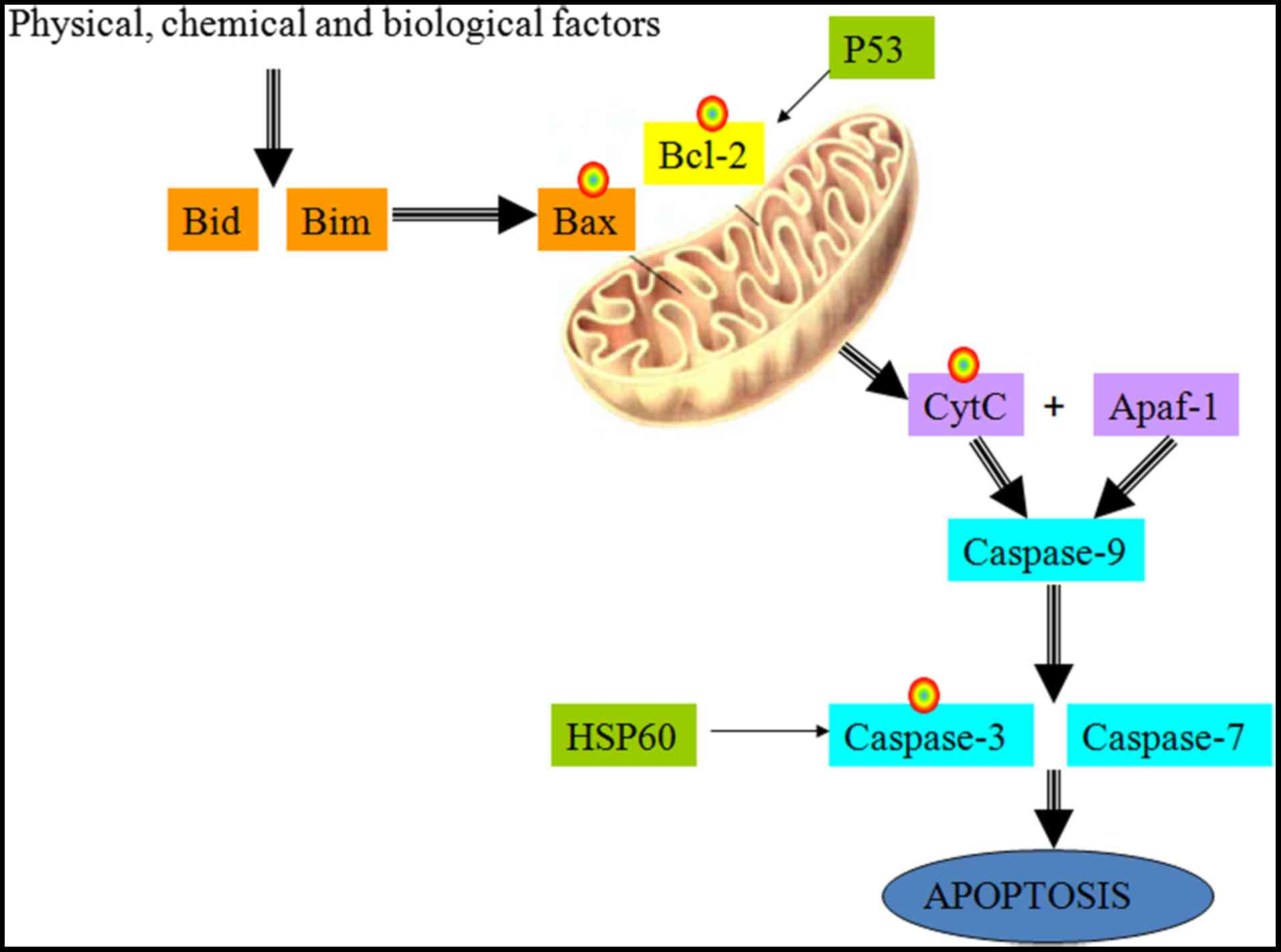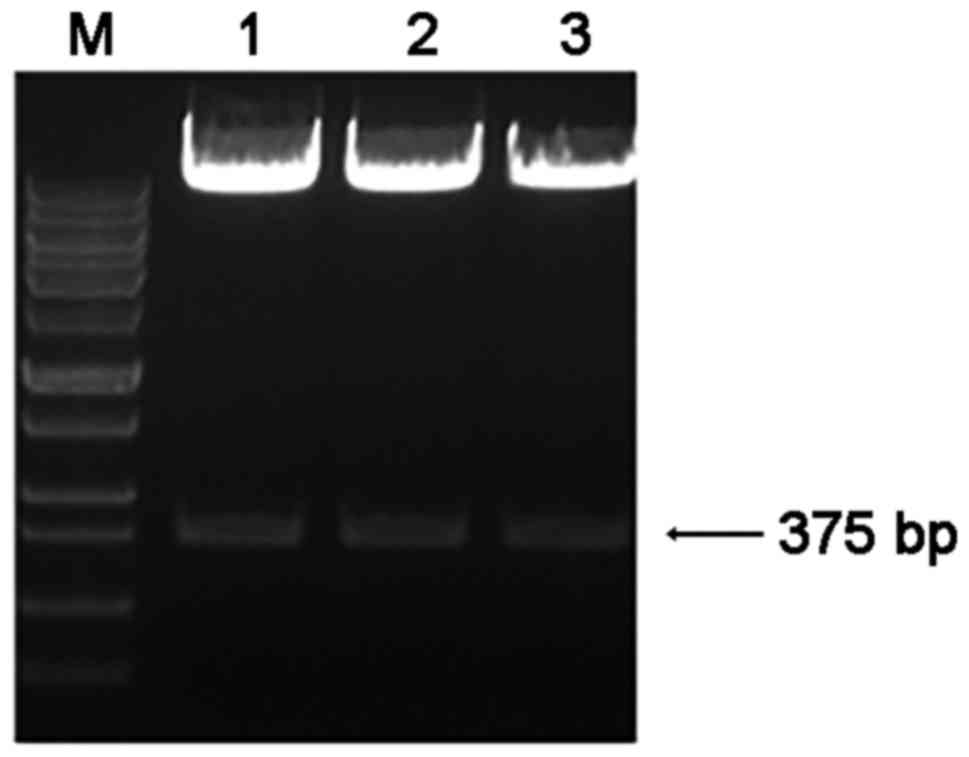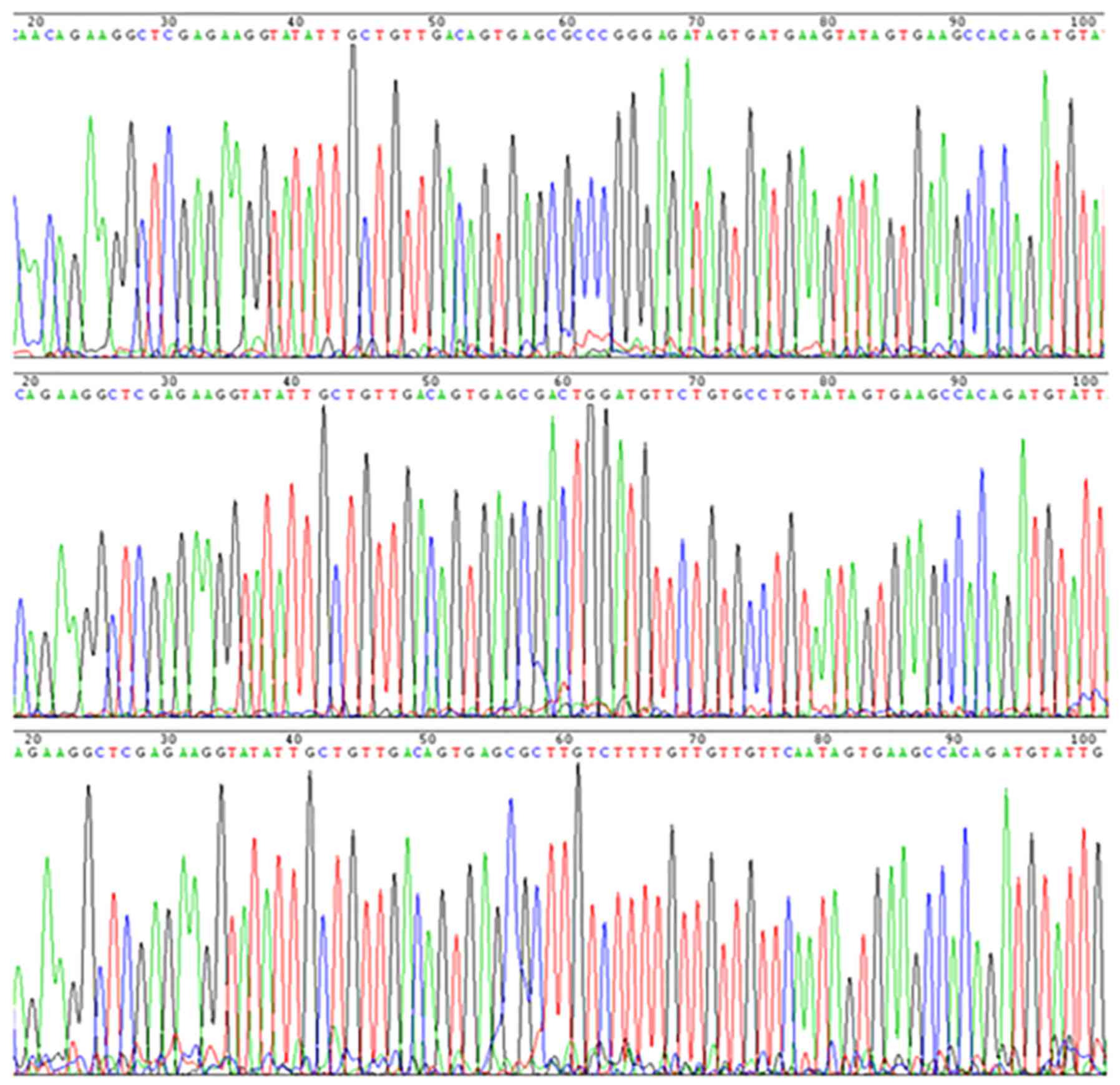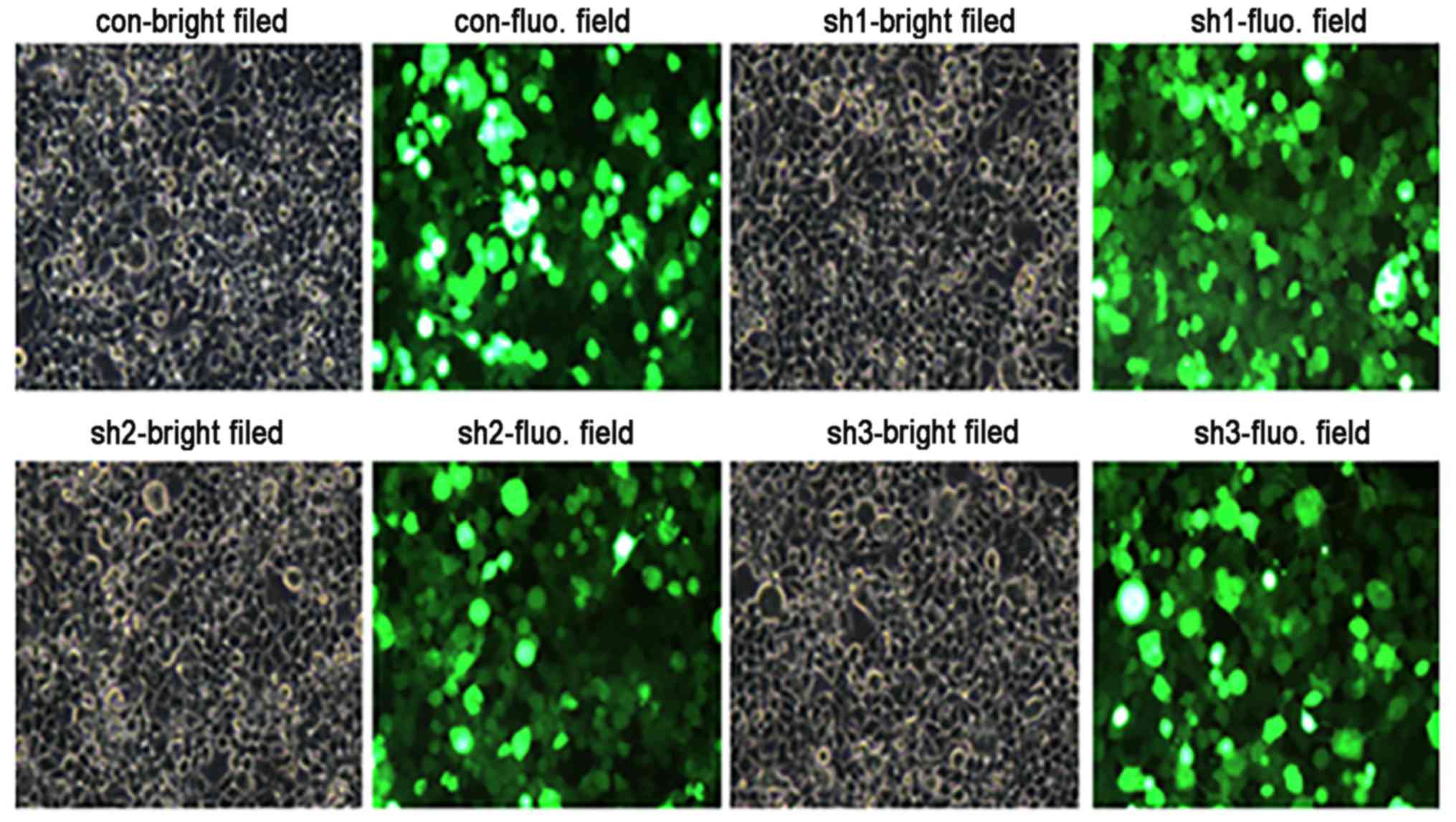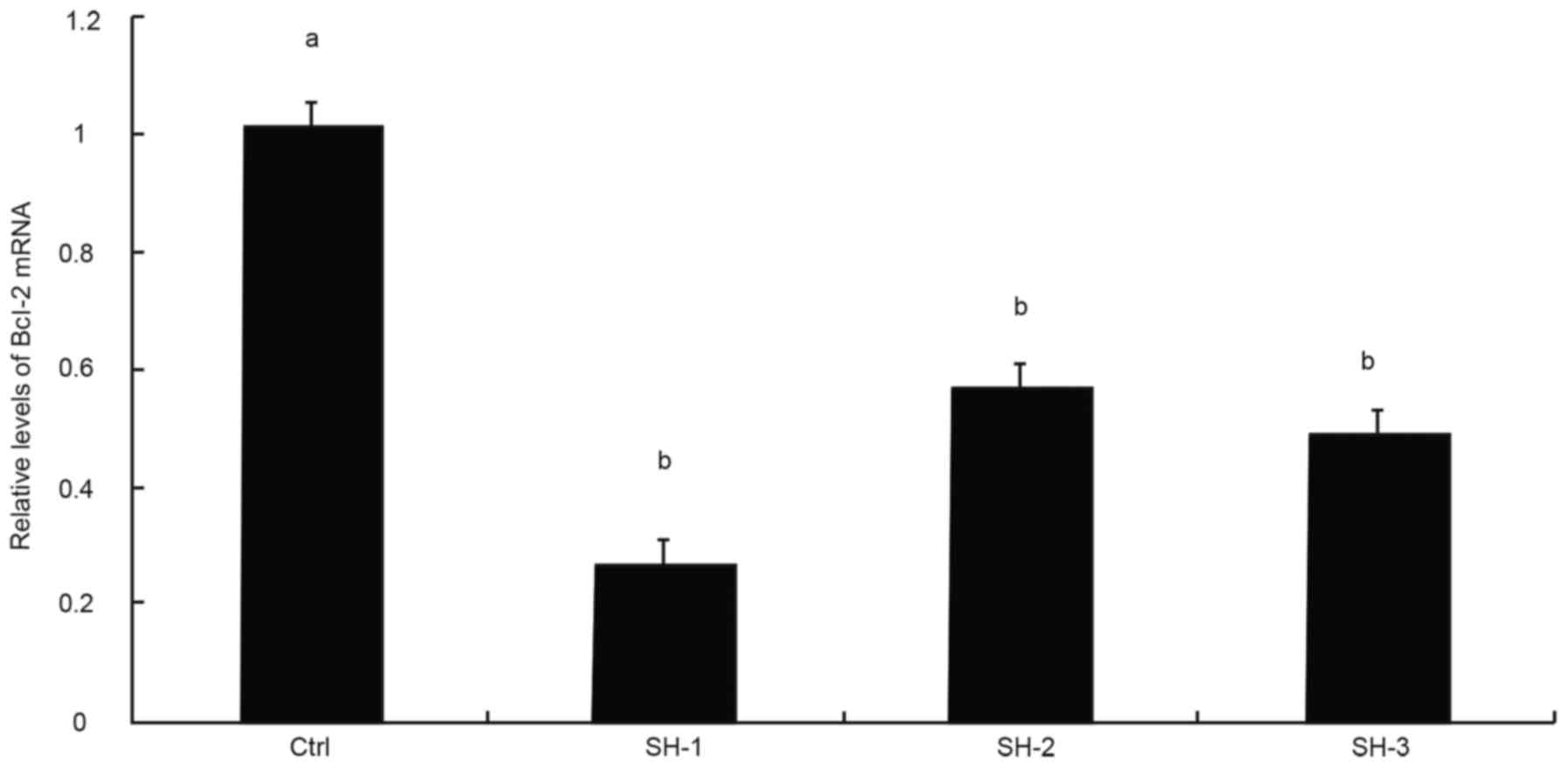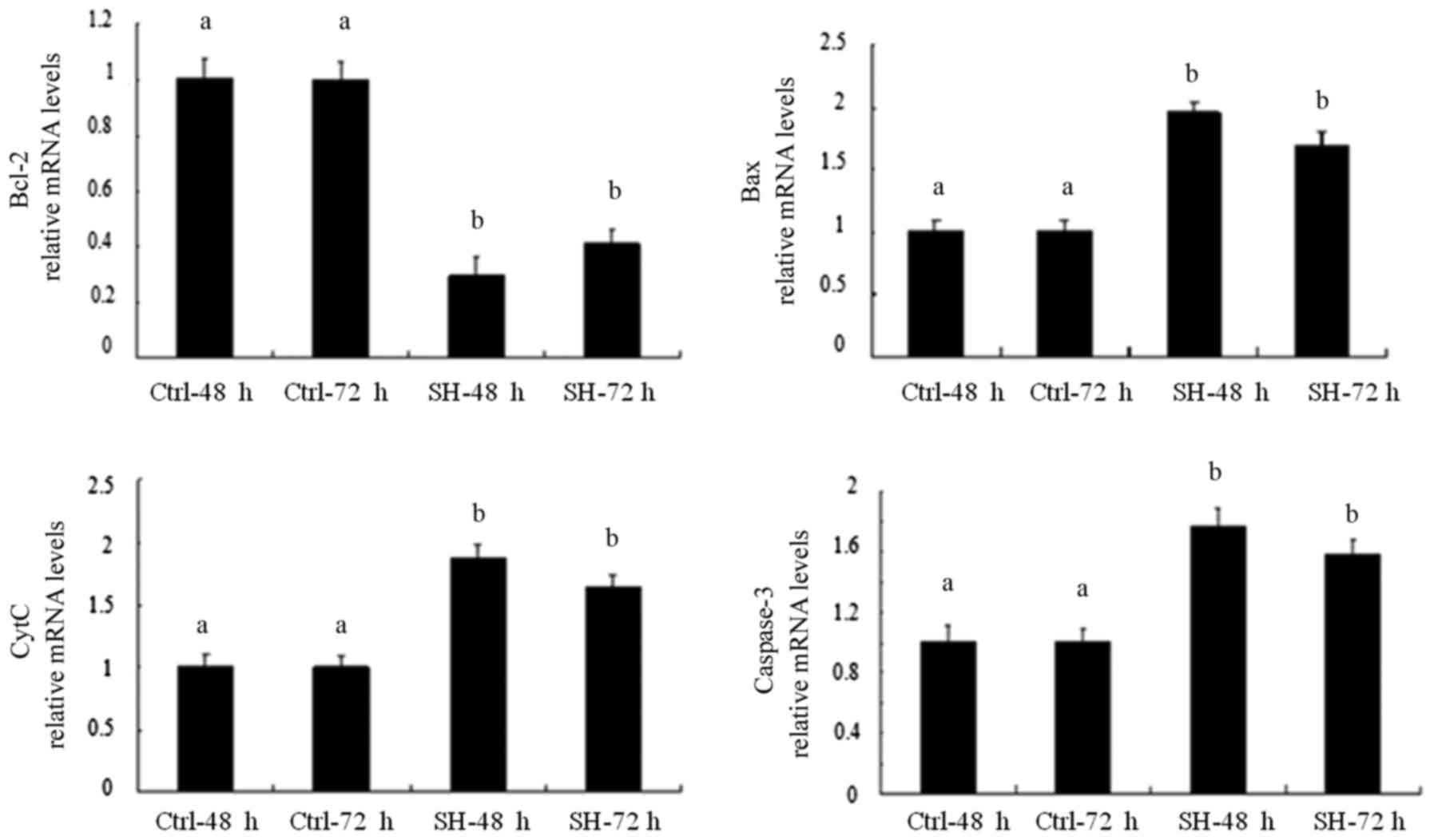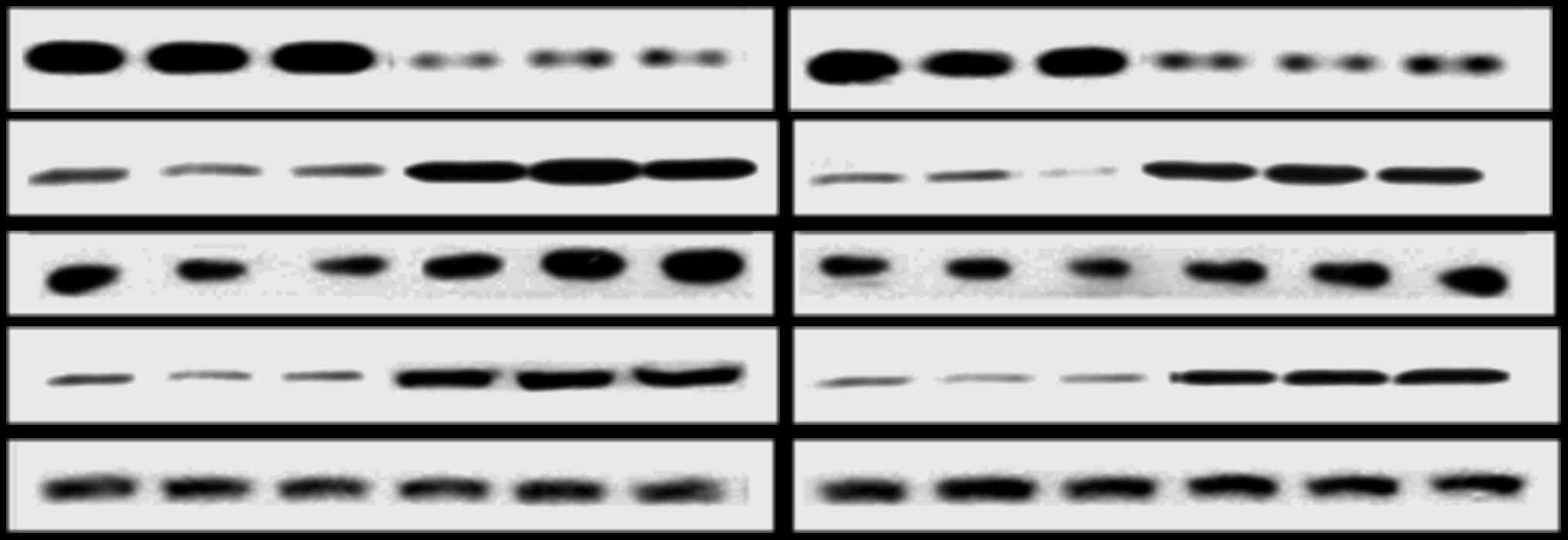Construction of a Bcl-2-shRNA expression vector and its effect on the mitochondrial apoptosis pathway in SW982 cells
- Authors:
- Published online on: September 27, 2017 https://doi.org/10.3892/ijmm.2017.3156
- Pages: 1914-1920
Abstract
Introduction
Rheumatoid arthritis (RA) is an autoimmune disease that is characterized by chronic progressive arthropathy (1,2). Apoptosis is considered to serve an important role in the pathogenesis of RA; in particular, there is a lack of apoptosis in synovial cells and an excess of apoptosis in cartilage cells (3,4). The mitochondrial signaling pathway is a common apoptotic pathway, in which the Bcl-2 family members function as pro-apoptotic and anti-apoptotic signal transduction factors. When apoptotic activation signals are received, Bax oligomerizes, escaping inhibition by Bcl-2, and is inserted into the mitochondrial membrane; the subsequent changes facilitate the release of CytC into the cytosol, where it interacts with the activating factor Apaf-1 to form a multimeric complex. Caspase-9 recruitment initiates the caspase cascade, which involves the activation of downstream Caspase-3 and eventually results in apoptosis (Fig. 1) (5–7).
As Bcl-2 is the initiating factor of the mitochondrial pathway, and its transcripts have been found to be highly expressed in the synovial tissues and cells of patients with RA (8), the present study aimed to design and synthesize human Bcl-2-short hairpin (sh)RNA expression vectors and assess their effects. The vectors were transformed into competent DH5α Escherichia coli (a genetically engineered Escherichia coli) cells, and then transfected into the human synovial sarcoma cell line SW982 for screening of an effective interference sequence. The expression levels of molecules associated with the mitochondrial pathway were then detected. The present study provides a theoretical and experimental basis for a potential molecular targeting treatment for RA.
Materials and methods
Materials
Type I collagenase, Dulbecco's modified Eagle's medium (DMEM)/F12 (glucose-free) and trypsin were purchased from Corning Inc. (Corning, NY, USA). DNA endonuclease enzymes (XhoI and MluI) were purchased from Shanghai Yu Bo Biological Technology Co., Ltd. (Shanghai, China). Lipofectamine 2000, First Strand cDNA Synthesis kit, Plasmid Extraction kit, Cell Total RNA Extraction kit, 2X SG Fast qPCR Master Mix and fetal bovine serum (FBS) were purchased from Bio Basic Inc. (Amherst, NY, USA). Human synovial sarcoma SW982 cells were purchased from Bohu Biotechnology Co. (Shanghai, China). Cells between passages 3 and 5 (P3–P5) were used in experiments.
Experiments were carried out in the Laboratory of Molecular Biology at the Bioengineering Biotechnology Company of Shanghai (Shanghai, China) between September and December 2016.
Design and synthesis of Bcl-2-shRNA
Using bioinformatics methods (9,10), the complete sequence of Bcl-2 mRNA (serial number: NM_000633.2) was acquired from GenBank, three sequences were designed for the target gene, and the corresponding sense and antisense oligonucleotides were designed and synthesized (Table I).
Construction of Bcl-2-shRNA interference vector
According to the instructions of the plasmid construction kit (DNA Blunting kit; Takara Bio, Inc., Shiga, Japan; cat. no. 6025), three pairs of shRNAs and a negative control oligonucleotide strand (each 5 µl) were respectively heated (95°C) for 5 min in the annealing buffer, and cooled for 20 min at room temperature. Following the formation of double chains, the oligonucleotides were ligated into the pHAV3.1-shRNA-tGFP vector by T4 DNA ligase. Subsequently, this mixture (10 µl) was added to 200 µl competent DH5α E. coli cells (Beijing World Gold Biotech Co., Ltd., Beijing, China) for the transformation step, in which the system was incubated on ice for 30 min, then heat-shocked at 42°C for 45 sec. Subsequently, lysogeny broth (LB) plates with ampicillin were coated with the E. coli, and the cells were cultured overnight at 37°C. Finally, positive clones were selected for the extraction of the DNA plasmids. The positive strains were cultured overnight in LB liquid culture medium, and the plasmids were extracted using the Plasmid Extraction kit, and then, using a double DNA endonuclease (XhoI and MluI) digestion for identification, the plasmids were sent to Invitrogen (Thermo Fisher Scientific, Inc., Waltham, MA, USA) to be sequenced.
Culture and passage of SW982 cells
The SW982 cells were cultured in DMEM-F12 containing 2.5% FBS and 5% horse serum, and were placed in an incubator at a temperature of 37°C with saturated humidity and 5% CO2. After the cells had grown to 80% confluence, they were transferred into a maintenance culture medium (DMEM/F12, 100 nmol/l dexa-methasone and 100 nmol/l insulin) for 8 days. The day after this, the medium was replaced and the cells were stained with Oil Red O.
Transfection of SW982 cells with the shRNA expression plasmid
In serum-free DMEM-F12 medium, SW982 cells were transfected with the Bcl-2 shRNAs and negative control plasmids using Lipofectamine 2000. SW982 cells were grouped into a control group (transfected with a negative control shRNA), and Bcl-2-sh1, Bcl-2-sh2 and Bcl-2-sh3 groups (transfected with Bcl-2-sh1, 2 and 3, respectively). Following transfection for 6 h, the culture medium was replaced by DMEM-F12 medium containing 10% FBS and the cells were cultured for a further 48–72 h. The number, intensity and distribution of successfully transfected cells, identified by their expression of green fluorescent protein (GFP), were observed by fluorescence microscopy at different time-points. If the fluorescence intensity was uniform and bright, the transfection efficiency was deemed to be high and the total RNA of the cells was extracted.
Screening for effective interference sequence by reverse transcription-quantitative PCR (RT-qPCR)
Total RNA was extracted from the cultured cells using the UNlQ-10 Column TRIzol Total RNA Isolation kit (Sangon Biotech Co., Ltd., Shanghai, China; cat. no. B511321) and was quantified by UV spectrophotometry (260 nm; NanoDrop ND-100; Thermo Fisher Scientific, Inc., Wilmington, DE, USA). RT was performed with the First Strand cDNA Synthesis kit (Sangon Biotech) and the resultant cDNA was used as the template for qPCR using a Prism 9700 StepOne™ Real-Time PCR system (Eastwin Life Sciences, Inc., Beijing, China). The primers were synthesized by Sangon Biotech. The thermal cycling conditions were as follows: 1 cycle of 95°C for 10 min; and 40 cycles of 95°C for 5 sec and 60°C for 30 sec. The 2−ΔΔCt method was used to calculate the transcript expression levels relative to those of β-actin, which served as an internal control (11). The sequence with the highest interference efficiency was selected according to the results of the quantitative detection of Bcl-2 mRNA.
Quantitative measurement of mitochondrial pathway gene expression levels
shRNA transfection, total RNA extraction and RT-qPCR were performed as described above. The primers used for gene-specific amplification are listed in Table II.
Quantitative measurement of mitochondrial pathway protein expression levels using western blotting
Total protein was isolated from the Bcl-2-sh1- and negative control-transfected cells using RIPA lysis buffer (Beyotime Biotech Co., Ltd., Shanghai, China) and subjected to western blot analysis. The protein concentration was determined by BCA assay (BCA assay kit; Beyotime Biotech). The total protein samples (40 µg) were resolved by 15% SDS-PAGE and electro-transferred onto nitrocellulose membranes. Non-specific binding sites were blocked by incubating the membranes at room temperature with 5X TBS with 10% BSA. Subsequently, the membranes were probed for mitochondrial pathway proteins through incubation with primary antibodies (all diluted 1:1,000; anti-Bcl-2, ab47489; anti-Bax, ab54829; anti-CytC, ab90529; anti-caspase-3, ab59388; and anti-tubulin, ab6046; all from Abcam, Cambridge, UK) for 60 min at 37°C, followed by incubation with the appropriate secondary antibodies (horseradish peroxidase-labeled goat anti-rabbit IgG; Sangon Biotech) for 60 min at 37°C. Immunoreactivity was detected by the enhanced chemiluminescence method using an ECL kit (Beyotime Institute of Biotechnology, Haimen, China). Data were obtained from at least three individual experiments performed in triplicate, and the expression levels of the mitochondrial pathway proteins were normalized to those of tubulin.
Statistical analysis
Statistical analyses were performed with the SPSS software (version 18.0; SPSS, Inc., Chicago, IL, USA). Data are expressed as the mean ± standard deviation, and inter-group differences were evaluated with a Student's t-test. P<0.05 was considered to indicate a statistically significant difference.
Results
Construction and identification of Bcl-2 shRNA expression plasmid
Bcl-2-shRNA expression plasmids 1, 2 and 3, which were identified by double enzyme digestion and 1% agarose gel electrophoresis, were synthesized successfully (Fig. 2). The shRNA expression plasmids were confirmed by sequencing analysis; the recombinant plasmids contained shRNA fragments, and the nucleotide sequences of the inserted fragments were complete, and were consistent with the designed sequences (Fig. 3).
Observation of Bcl-2 shRNA expression plasmid-transfected SW982 cells by fluorescence microscopy
Following the transfection of Bcl-2 shRNA expression plasmids into SW982 cells (P3–P5), GFP expression was observed by fluorescence microscopy. GFP expression peaked at 48 h, and the fluorescence intensity in the cytoplasm was uniform and bright, which indicated that the transfection was successful (Fig. 4).
Expression of target gene Bcl-2 and screening for an effective interference sequence
RT-qPCR was used to detect the efficacy of Bcl-2 inhibition in transfected SW982 cells, which revealed that the Bcl-2-sh1, Bcl-2-sh2 and Bcl-2-sh3 plasmids significantly reduced Bcl-2 mRNA levels compared with the negative control group (P<0.05). The effect of Bcl-2-sh1 was the most pronounced (inhibition rate >75%). Therefore, Bcl-2-sh1 was selected as the most effective interference sequence and was used for subsequent experiments (Fig. 5).
Effect of Bcl-2-sh1 on the expression of mitochondrial pathway molecules
At 48 and 72 h following the transfection of Bcl-2-sh1 into SW982 cells, the mRNA and protein expression levels of Bcl-2, Bax, caspase-3, CytC were assessed. The results indicated that, compared with the control group, the expression of Bcl-2 was significantly decreased, while on the contrary, Bax, CytC and Caspase-3 were significantly increased at the mRNA and protein levels; all differences were statistically significant (P<0.05). The effects of the Bcl-2 shRNA on the levels of Bcl-2, Bax, CytC and Caspase-3 were more pronounced at 48 h than at 72 h post-transfection (Figs. 6 and 7).
Discussion
Previous studies have demonstrated that the biological characteristics of synovial cells in patients with RA are markedly altered. Notably, significant enhancements in the proliferative rate and migratory ability of the cells have been observed. In addition, the Bcl-2 gene has been shown to be overexpressed in the synovial tissue and fibroblast-like synovial cells of RA patients, resulting in a deficiency in the apoptosis of inflammatory cells and an imbalance in immune homeostasis (12,13). The human synovial sarcoma cell line SW982 possesses the characteristic of abnormal proliferation, similar to RA synovial tissue; therefore, its use for the study of RA has been recognized (14–16).
shRNA is a highly efficient gene-silencing molecule; compared with the traditional gene-silencing technologies, including gene knockout, negative mutation and antisense RNA, it has several advantages (17–19). Therefore, in the present study, the authors designed and synthesized Bcl-2 shRNA and transfected it into the SW982 cell line to observe its effects on the expression of mitochondrial apoptosis pathway genes, including Bcl-2, Bax, CytC and Caspase-3, in order to further study the relevance of this pathway to RA.
The reason for the selection of the Bcl-2 gene fragment for shRNA interference in the present study was the position and function of this gene in the mitochondrial pathway. Bcl-2 is an inhibitor of apoptosis and, as it is located upstream of the mitochondrial pathway, it is critical to the inhibition of this pathway. The Bcl-2 transmembrane protein contains two types of Bcl-2 homology (BH) domains: BH1 and BH2. At these regions, Bcl-2 and the pro-apoptotic gene Bax can form heterodimers or homodimers; this interaction is the basic mechanism by which Bcl-2 suppresses apoptosis (20,21). The abnormal proliferation of synovial cells in patients with RA is associated with high expression of Bcl-2. Therefore, the authors hypothesized that the construction of a Bcl-2-shRNA could directly activate the mitochondrial pathway at the source, enabling abnormal synovial cells to undergo apoptosis.
In the present study, bioinformatics methods were used in the design process, and the Bcl-2 mRNA sequences were obtained from GenBank. Sequences that were highly homologous with other genes were removed, and the GC content of the sequence was strictly limited to 35–55%. For the loop structure in the shRNA template, in order to avoid the formation of a termination signal, the TTCAAGAGA sequence was selected. Three target sequences were designed, and the expression-vector method was used to prepare the shRNA (22–24). This method uses a plasmid with a resistance marker as a vector for transfection of the shRNA into cells, so as to achieve sustained suppression of target gene expression (25,26). The results demonstrated that all three Bcl-2 shRNAs could inhibit the expression of Bcl-2 in SW982 cells, and the effect of Bcl-2-sh1 was the most obvious.
At 48 and 72 h following the transfection of Bcl-2-sh1 into SW982 cells, the results showed that the expression of Bcl-2 was significantly decreased, while the expression levels of Bax, CytC and Caspase-3 were significantly increased compared with those in the control group. Thus, the effectiveness of shRNA-mediated interference of Bcl-2 in human SW982 cells was confirmed, and it was demonstrated that this could indirectly promote the expression of other pro-apoptotic genes in the mitochondrial pathway. Since Bcl-2 and Bax exist in the form of homodimers or heterodimers, once the level of Bcl-2 is greater, Bcl-2/Bcl-2 homodimers are formed, and apoptosis is inhibited. Bcl-2-shRNA inhibited the expression of the Bcl-2 gene and thereby changed the proportion of Bcl-2/Bax, thus enhancing the expression of the pro-apoptotic gene Bax. Bax is a promoter of the mitochondrial pathway that promotes the release of CytC, activates Caspase-3 and induces apoptosis of synoviocytes (27).
In summary, the interference effect of Bcl-2-sh1 on BCL-2 was more pronounced than that of the other two sequences, which demonstrated that, although many shRNA sequences may be designed for the same target gene, the interference effect might differ due to the different target sequences. With regard to the time-points, the interference effect of Bcl-2-sh1 was greater at 48 h than at 72 h post-transfection, indicating that the inhibitory effect of the shRNA was decreased over time; therefore, it is necessary to investigate ways of prolonging the silencing effect.
Acknowledgments
The present study was supported by grants from the Development Fund and Innovation Fund of Science and Technology (Medical and Health Projects) in Pudong New District of Shanghai, China (grant nos. PKJ2015-Y24 and 2015/05-2018/05).
References
|
Macintyre NJ, Muller ME, Webber CE and Adachi JD: The relationship between radial bone properties and disease activity and physical function in individuals with rheumatoid arthritis. Physiother Can. 64:284–291. 2012. View Article : Google Scholar : | |
|
Navalho M, Resende C, Rodrigues AM, Pereira da Silva JA, Fonseca JE, Campos J and Canhão H: Bilateral evaluation of the hand and wrist in untreated early inflammatory arthritis: A comparative study of ultrasonography and magnetic resonance imaging. J Rheumatol. 40:1282–1292. 2013. View Article : Google Scholar : PubMed/NCBI | |
|
Krabben A, Abhishek A, Britsemmer K, Filer A, Huizinga TW, Raza K, van Schaardenburg DJ and van der Helm-van Mil AH: Risk of rheumatoid arthritis development in patients with unclassified arthritis according to the 2010 ACR/EULAR criteria for rheumatoid arthritis. Rheumatology (Oxford). 52:1265–1270. 2013. View Article : Google Scholar | |
|
Shin SY, Katz P, Wallhagen M and Julian L: Cognitive impairment in persons with rheumatoid arthritis. Arthritis Care Res (Hoboken). 64:1144–1150. 2012. | |
|
Li R, Yan G, Li Q, Sun H, Hu Y, Sun J and Xu B: MicroRNA-145 protects cardiomyocytes against hydrogen peroxide (H2O2)-induced apoptosis through targeting the mitochondria apoptotic pathway. PLoS One. 7:449072012. View Article : Google Scholar | |
|
Mane SD, Thoh M, Sharma D, Sandur SK and Naidu KA: Ascorbyl stearate promotes apoptosis through intrinsic mitochondrial pathway in HeLa cancer cells. Anticancer Res. 36:6409–6417. 2016. View Article : Google Scholar : PubMed/NCBI | |
|
Zhang WD, Zhang Z, Zhang H, et al: Oxygen free radicals and mitochondrial signaling in oligospermia and asthenospermia. Mol Med Rep. 10:1875–1880. 2014. View Article : Google Scholar : PubMed/NCBI | |
|
Yan C, Kong D, Ge D, Zhang Y, Zhang X, Su C and Cao X: Mitomycin C induces apoptosis in rheumatoid arthritis fibroblast-like synoviocytes via a mitochondrial-mediated pathway. Cell Physiol Biochem. 35:1125–1136. 2015. View Article : Google Scholar : PubMed/NCBI | |
|
Liu L, Liu Y, Zhang X, Chen M, Wu H, Lin M, Zhan Y, Zhuang C, Lin J, Li J, et al: Inhibiting cell migration and cell invasion by silencing the transcription factor ETS-1 in human bladder cancer. Oncotarget. 7:25125–25134. 2016. View Article : Google Scholar : PubMed/NCBI | |
|
Li G, Zhang L, Liu J, Xiao T, Liu G, Wang J and Hou M: shRNA-mediated RPS15A silencing inhibits U937 acute myeloid leukemia cell proliferation and enhances apoptosis. Mol Med Rep. 13:4400–4406. 2016. View Article : Google Scholar : PubMed/NCBI | |
|
Livak KJ and Schmittgen TD: Analysis of relative gene expression data using real-time quantitative PCR and the 2(−Delta Delta C(T)) Method. Methods. 25:402–408. 2001. View Article : Google Scholar | |
|
Liu H, Yang Y, Cai X, Gao Y, Du J and Chen S: The effects of arctigenin on human rheumatoid arthritis fibroblast-like synoviocytes. Pharm Biol. 53:1118–1123. 2015. View Article : Google Scholar : PubMed/NCBI | |
|
Liu QS, Luo XY, Jiang H, Xing Y, Yang MH, Yuan GH, Tang Z and Wang H: Salvia miltiorrhiza injection restores apoptosis of fibroblast-like synoviocytes cultured with serum from patients with rheumatoid arthritis. Mol Med Rep. 11:1476–1482. 2015. View Article : Google Scholar | |
|
Sugiyama R, Agematsu K, Migita K, Nakayama J, Mokuda S, Ogura F, Haraikawa K, Okumura C, Suehiro S, Morikawa S, et al: Defect of suppression of inflammasome-independent interleukin-8 secretion from SW982 synovial sarcoma cells by familial Mediterranean fever-derived pyrin mutations. Mol Biol Rep. 41:545–553. 2014. View Article : Google Scholar | |
|
Beaulieu E, Green L, Elsby L, Alourfi Z, Morand EF, Ray DW and Donn R: Identification of a novel cell type-specific intronic enhancer of macrophage migration inhibitory factor (MIF) and its regulation by mithramycin. Clin Exp Immunol. 163:178–188. 2011. View Article : Google Scholar : | |
|
Gupta A, Niger C, Buo AM, Eidelman ER, Chen RJ and Stains JP: Connexin43 enhances the expression of osteoarthritis-associated genes in synovial fibroblasts in culture. BMC Musculoskelet Disord. 15:4252014. View Article : Google Scholar : PubMed/NCBI | |
|
Snead NM and Rossi JJ: RNA interference trigger variants: Getting the most out of RNA for RNA interference-based therapeutics. Nucleic Acid Ther. 22:139–146. 2012.PubMed/NCBI | |
|
Nishioka N, Matsuoka T, Yashiro M, Hirakawa K, Olden K and Roberts JD: Plasminogen activator inhibitor 1 RNAi suppresses gastric cancer metastasis in vivo. Cancer Sci. 103:228–232. 2012. View Article : Google Scholar | |
|
Jung HS and Shin YK: The potential RNAi-based combination therapeutics. Arch Pharm Res. 34:1–2. 2011. View Article : Google Scholar : PubMed/NCBI | |
|
Stornaiuolo M, La Regina G, Passacantilli S, Grassia G, Coluccia A, La Pietra V, Giustiniano M, Cassese H, Di Maro S, Brancaccio D, et al: Structure-based lead optimization and biological evaluation of BAX direct activators as novel potential anticancer agents. J Med Chem. 58:2135–2148. 2015. View Article : Google Scholar : PubMed/NCBI | |
|
Siddiqui WA, Ahad A and Ahsan H: The mystery of BCL2 family: Bcl-2 proteins and apoptosis: an update. Arch Toxicol. 89:289–317. 2015. View Article : Google Scholar : PubMed/NCBI | |
|
Afonin KA, Grabow WW, Walker FM, Bindewald E, Dobrovolskaia MA, Shapiro BA and Jaeger L: Design and self-assembly of siRNA-functionalized RNA nanoparticles for use in automated nanomedicine. Nat Protoc. 6:2022–2034. 2011. View Article : Google Scholar : PubMed/NCBI | |
|
Mysara M, Garibaldi JM and Elhefnawi M: MysiRNA-designer: A workflow for efficient siRNA design. PLoS One. 6:e256422011. View Article : Google Scholar : PubMed/NCBI | |
|
Hefferon KL: Innovations in siRNA research: A technology comes of age. Recent Pat Antiinfect Drug Discov. 5:226–239. 2010. View Article : Google Scholar : PubMed/NCBI | |
|
Wang Y, Li Z, Han Y, Liang LH and Ji A: Nanoparticle-based delivery system for application of siRNA in vivo. Curr Drug Metab. 11:182–196. 2010. View Article : Google Scholar : PubMed/NCBI | |
|
Sarret P, Doré-Savard L and Beaudet N: Direct application of siRNA for in vivo pain research. Methods Mol Biol. 623:383–395. 2010. View Article : Google Scholar : PubMed/NCBI | |
|
Yuan S, Wu B, Yu Z, Fang J, Liang N, Zhou M, Huang C and Peng X: The mitochondrial and endoplasmic reticulum pathways involved in the apoptosis of bursa of Fabricius cells in broilers exposed to dietary aflatoxin B1. Oncotarget. 7:65295–65306. 2016.PubMed/NCBI | |
|
Zhang W: Research of the pathogensis of oxygen free radicals-mitochondrion pathway in oligospermia and asthenospermia. Chinese doctoral dissertation full text database. May;2015. |



